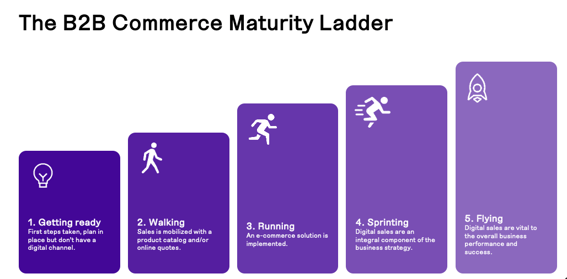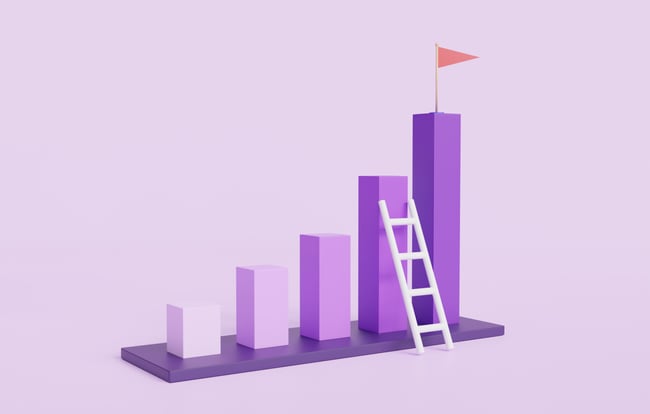In our latest publication, the "Nordic B2B Commerce Maturity Ladder," we delve into the ever-evolving landscape of digital B2B sales in the Nordic region. Beyond providing valuable insights into the key drivers behind this digital transformation, our B2B Commerce Maturity Ladder visualize the progress companies have made in their digital journey.
The B2B Commerce Maturity Ladder consists of five distinct stages, each representing a different milestone in a company's digital evolution:
1. Step 1: "Getting Ready" (5%) This stage is reserved for companies that have not yet ventured into digital sales but have concrete plans to launch a webshop within the next three years.
2. Step 2: "Walking" (37%) At this level, companies do not offer a digital sales channel, but they support traditional sales through their digital platforms. They allow customers to browse a digital product catalog and request prices or quotes online.
3. Step 3: "Running" (30%) Companies in this category enable their business customers to purchase products or services through a professional webshop or e-commerce solution. Digital sales are viewed as a significant complement to traditional B2B sales channels.
4. Step 4: "Sprinting" (16%) In the Sprinting phase, digital sales and e-commerce are fully integrated into the company's business and sales strategy. Robust digital marketing efforts support digital sales through various channels.
5. Step 5: "Flying" (12%) At the pinnacle of the ladder, e-commerce is the cornerstone of the company's business model, representing a substantial share of all sales. Data analysis and continuous business evaluation are considered indispensable for further business development.

Advancements in B2B Digital Commerce Maturity
When comparing these numbers to our previous report in 2021, you can observe positive progress among companies on the maturity ladder. In 2021, the "Getting Ready" stage accounted for 8% of companies, while in the current report, it has decreased to 5%. Conversely, the "Flying" stage, which represented 10% in 2021, has now increased to 12%. This indicates a promising trend, showcasing the advancing maturity of digital commerce within the B2B sector.
Utilizing the B2B Commerce Maturity Ladder
The B2B Commerce Maturity Ladder is not meant to be a one-size-fits-all blueprint for companies striving to become more digital. Instead, it serves as a benchmark to illuminate the evolving B2B market landscape and the potential opportunities that lie ahead. The digital realm offers a vast array of possibilities, and businesses must explore various avenues in their quest for increased digitization.
While many companies initiate their digital journey by enabling customers to request quotes online or browse digital catalogs, it's essential to recognize that alternative solutions might better suit your specific needs.
Moreover, the significance of data and analysis in optimizing digital sales cannot be overstated. Mapping the customer journey, understanding conversion rates, and implementing a structured system for analysis and channel management are pivotal components in ascending the maturity ladder and reaping the full benefits of digital transformation.
In summary, the B2B Commerce Maturity Ladder serves as a valuable tool for determining the next steps your company should take in its digital evolution. Consistently moving forward in a positive direction not only meets customer demands but also enhances sales and ultimately boosts profits. For more in-depth insights and information on the world of digital B2B sales, download the full report here: www.litium.com/maturity-ladder. Stay ahead of the curve in the ever-changing landscape of digital commerce in Nordics!
